Customers love and engage with eco-conscious brands. As people become increasingly aware of environmental issues, they’re becoming more aware of the brands they use and how they impact the environment.
Environmental concerns are shaping purchasing decisions more and more, and ‘going green’ can be a valuable driver of revenue and growth!
According to a survey by Nielson, 48% of shoppers in the US would change their consumption habits if it reduced negative eco impacts, 92% of consumers find it easier to trust socially and environmentally conscious brands, and 88% say they would be more loyal to these companies.
So, how does environmental marketing work? And why isn’t everyone doing it already?
In this guide, we set out what environmental marketing is, how it differs from greenwashing, and some examples of successful environmental marketing campaigns to learn from!
Ready?
Let’s go (green)!
Environmental marketing emphasizes what businesses do to protect the environment and minimize the negative impacts they contribute. Brands receive a lot of criticism for using materials and distribution channels that harm the environment.
And with the growing concern about detrimental environmental issues like climate change and deforestation, customers are expecting companies to find eco-friendly ways to do what they do.
Developing an environmental marketing strategy has become imperative for businesses because buyers are making more eco-friendly buying decisions.
For example, if your products are wrapped in layers and layers of single-use plastic, how would you expect customers to perceive your brand?
If they’re an environmentally conscious consumer, they’re more likely to pick up the alternative which is in paper packaging, or a reusable/recyclable container.
Some studies have shown that consumers are even prepared to pay more for a product they see as being the more eco-friendly choice.
Some of the benefits of environmental marketing for businesses include:
But here’s the thing – environmental marketing campaigns can also harm your reputation!
And you need to understand what greenwashing is and how this differs from environmental marketing to avoid a PR nightmare:
Summary: What is Environmental Marketing?
Environmental marketing emphasizes how businesses make decisions that protect the environment and reduces how badly they impact it. Consumers are becoming aware of how their purchasing choices affect the environment. And because of this, buyers are making more eco-conscious purchases. Brands must embrace environmentalism to help the planet and convert customers.
Source: team Sourcing Eco
Greenwashing is when businesses are dishonest to capitalize on the benefits of environmental marketing without making a notable impact. After seeing how environmental marketing can elevate brands, some choose to market themselves as eco-friendly, but this wasn’t true (or was much less true than they claimed).
A significant number of brands are guilty of greenwashing. Many have been able to fly under the radar but others have been called out and taken massive reputational damage as a result.
So, what sets environmental marketing apart from greenwashing?
Environmental marketing is honest, transparent, and accountable. Highlighting what a brand is doing right is always a good idea, as long as you don’t exaggerate or otherwise mislead your consumers.
Good environmental marketing makes factual claims, that can be easily verified, and that contain all the relevant information.
Green claims like ‘made with 30% recycled materials’ are very, very common. And often just as misleading. If making that product with recycled materials (as many are, to save costs) is the industry norm and that brand is not doing anything to lessen its impact on the environment, that amounts to greenwashing even if the claim is factually correct.
The context matters, and that is where environmental marketers have to be careful.
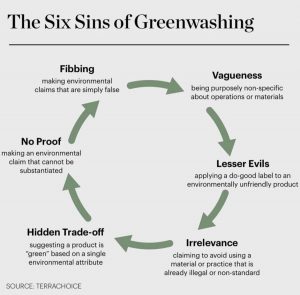
Environmental marketing is when companies market themselves as eco-friendly and live up to it. Many brands make the honest mistake of saying they’re eco-friendly without taking all the correct measures to fulfill these claims.
Here are a few factors that show the difference between whether a company deploys environmental marketing vs. greenwashing.
Most products and packaging materials aren’t very environment-friendly. There is no point in cutting a percentage of plastic out of a product container, and then shipping it in more plastic than before to protect it in transit. This discrepancy will be picked up immediately by any eco-conscious consumer, and most likely lead to a (potentially viral) social media post.
For environmental marketing, businesses need to reconsider all materials and opt for eco-friendly solutions all the way along the process. You can start anywhere, and you can market that effort, no matter how small, as long as you put it in context, and are transparent about it.
It can be as simple as a box that says ‘recyclable packaging’ vs the same box that says ‘recyclable outer packaging’. The best option is ‘100% recyclable packaging’ but if that is not the case, make the claim that is true.
It’s tricky for businesses to adopt eco-friendly solutions for all their activities. There may be various barriers to consider between your consumers and products. However, for successful environmental marketing, this is the commitment you must make.
If we consider greenwashing, it’s much different.
Companies may want to switch eco-friendly marketing but don’t evaluate what is and isn’t really sustainable. While some businesses assume they’re making an active effort, they’re not. Or, businesses are outright using products that harm the environment while marketing their offerings as eco-friendly.
Greenwashing is often vague, incomplete, or outright false claims about a product or the materials used in that product. The fast fashion industry is notorious for this. An organic cotton shirt that is manufactured in a way that is much more damaging for the environment (to say, offset the cost of buying organic cotton) than the industry norm is not a more sustainable option, and marketing it as such is misleading.
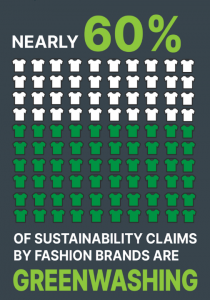
Here’s where companies get burned by PR backlash for greenwashing the most. Eco-friendly brands disclose that their products and marketing materials are sustainable, and it’s true.
Many companies disclose this in ad campaigns or on the products’ packaging. For instance, if you’re using an eco-friendly paper solution (yes, that’s a thing) rather than typical paper, you can disclose this on the product or in marketing campaigns you deploy.
But in cases of greenwashing, what companies tell the public isn’t 100% accurate in terms of using eco-friendly materials. It’s not always intentional, and some brands don’t evaluate what goes into developing their products well enough.
Because of greenwashing, many consumers don’t believe companies promoting their products as eco-friendly. It’s also much easier to get torn apart by the press if your claims are false.
It’s obvious what the PR impact is for environmental marketing vs. greenwashing. Buyers praise sustainable businesses, and it’s easier to get positive PR.
Customers are more aware of how severely harmful products are to the environment, so they encourage and engage with sustainable companies. If customers use your products on their skin, hair, body, face, etc., you’ll get much more traction using eco-friendly products.
A simple example of this is hair shampoos that include parabens. Parabens are bad for the environment and hair. Buying shampoos with this ingredient was standard before. Consumers now know parabens are harmful, so they look for more environmentally positive products. And haircare brands that have adapted to biodegradable ingredients receive better responses from the public.
But some businesses don’t do enough research on whether their products or marketing materials are harmful to the environment. And may market themselves as sustainable because, to their knowledge, they are.
It won’t be long before the public finds out. And when they do, this is how buyers will respond:
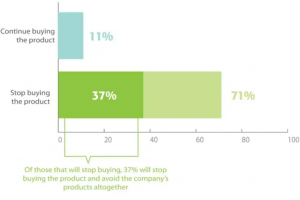
Publications are always looking for the next hot take, and if your business is big enough, you’ll quickly land on the wrong side of buyers.
Imagine headlines about your business like, “Boston’s Biggest E-commerce Store Murders Millions of Mammals” or “This Brand Believes Marketing is Worth Air Pollution”.
Summary: Environmental Marketing vs. Greenwashing
Environmental marketing is when businesses ensures they make marketing and operational choices to positively impact the environment. Greenwashing is when companies claim to offer sustainable products and use eco materials, but this isn’t 100% accurate. These companies are capitalizing of customers’ response to environmental marketing without making an impact.
The differences between environmental marketing and greenwashing is:
Between Green, an initiative started by Jodie Clough is a subscription service and advocate for environmental marketing. Customers can join a monthly subscription to receive a box of eco-friendly products. These products are from local businesses in the UK, such as Plant-Based Hipster, Moonie, and Eco Party Bag.
The purpose of these eco-friendly products is to help consumers live sustainable lifestyles. A few of these goodies include chemical-free cleaning products, eco hand and nail care creams, stationary produced from recycled materials, and plastic-free dental care items.

What inspired this subscription service is Jodie Clough’s passion for sustainable products. Being diagnosed with depression and anxiety, Jodie was encouraged to use everyday products that enhanced her life. After realizing how removing toxins, chemicals, and plastic over time improved her life, she shared this passion through Between Green.
At first, Between Green was about sustainable products promoted and sold at artisan markets and events. But after Covid-19, Jodie migrated her business online, with the core offering being her sustainable subscription boxes.
Thanks to her efforts to make the world a greener place, Amazon Prime approached Jodie to create a show about Between Green and its mission for 2022. Many small businesses have also reached out to collaborate with this brand. Customers across the UK and Canada have also said how environmentally aware this brand has helped them become.
Here’s what you should consider for your environmental marketing campaign from Between Green:
Hunderunde is a social business with a mission to elevate animal welfare. After witnessing the terrible conditions stray dogs survive in, in Romania, Luis Kesten partnered with his friend Fabio Lehert to start Hunderunde.

Hunderunde sells eco-friendly products like locally made bracelets, engraved dog bowls, and apparel, among other products. Ensuring their offerings don’t harm the environment, the founders use eco-friendly solutions for every aspect of their products and marketing efforts.
When customers purchase an item from Hunderunde, the company donates a portion of the purchase to an animal activist in Romania, Mirela. Mirela currently takes care of over 200 stray dogs, giving them enough food and water alongside an abundance of love.
Almost 90% of consumers would buy products if they had a positive environment or social impact, so it’s no surprise why Hunderunde was successful. Thanks to eco marketing, Hunderunde has significantly extended its product line, and the founders have a self-published book.
What you should learn from Hunderunde’s environmental marketing campaign is:
Patagonia isn’t a 100% green brand using fossil fuels for some of its outdoor clothing and gear. However, this brand does disclose this to its customers. Patagonia also makes an effort to help the environment in many different ways.
For starters, Patagonia is an avid environmental activist supporting environmental NGOs to preserve air, land, and water. They’ve implemented a self-imposed tax of 1% to contribute toward these NGOs.
Secondly, although Patagonia’s products aren’t 100% eco-friendly, for the most part, they are. This company recycles materials to develop its products. Patagonia also has strict policies to regulate its supply chain operations and how this impacts the environment.

But that’s not all. This company contributes to research with environmental bodies to determine the effect of microplastics and possible solutions. And Patagonia has rigid rules for its formal animal welfare policy and how this influences its product development.
As another effort to go green, Patagonia has a program allowing consumers to donate to their loved one’s favorite charity as a gift. While Patagonia may use some products that aren’t green, they have made a dent in eco-awareness and encouraged sustainable living.
To achieve environmental marketing success, consider what eco-friendly choices Patagonia has made like:
Pokémon Go is a popular augmented reality game worldwide. Because of its power to influence a large customer base, Pokémon Go decided to go green with an experiential marketing campaign for Earth Day.

Pokémon Go started working with local NGOs to motivate its global gamers to clean the planet on Earth day. The brand dubbed this environmental marketing campaign “the Go Earth Day Cleanup”.
What made this environmental marketing campaign successful is the experiential approach. Within a 48-hour window cleanup, users could earn in-game rewards and unlock exclusive items for participating in this initiative. Rather than making it seem like a chore to clean the ocean and planet, gamers helped the environment through interactivity.
These are the pointers to take away from Pokemon Go’s environmental marketing campaign:
Unilever is a global manufacturer with many globally-beloved products behind its success. Some of these brands are Dove, Lipton, and Axe. But amid all this manufacturing comes an excessive usage of plastic. And as we know, plastic is detrimental to the environment.
But Unilever decided to incorporate and promote sustainability in its mission by reducing virgin plastics in its products. Virgin plastics are plastic lacking any recycled material at all. Between 2018 and 2021, Unilever decreased the number of virgin plastics it used by 16%. Now more than 17% of its plastic footprint comprises post-consumer recycled plastic.
Unilever didn’t stop there and chose to create a set of goals to help their company use less, better or no plastic for their packaging. By 2025, this company sets out to:
Because Unilever took the time to reconsider the use of plastic in its packaging and found better solutions, many publications have shared this with the public. And a giant company like Unilever can always benefit from fantastic PR!
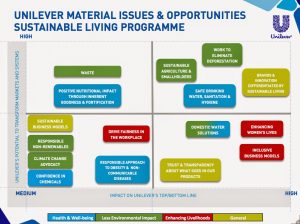
If a giant manufacturing company like Unilever can practice environmental marketing, so can you! Here’s what you can learn from Unilever:
Imagine e-commerce was a 100% sustainable industry. Well, that’s what Priority Direct aims to accomplish! This green brand specializes in eco-friendly packaging products like labels and other packaging essentials.

Priority Direct is now considered the UK’s leading planet-friendly packaging company. Besides providing eco solutions for packaging, the company also educates customers on environmental awareness and how to make better choices to sustain the planet.
Transforming businesses in the e-commerce space to 100% eco-solutions doesn’t happen overnight. But Priority Direct has made impressive progress so far. Within just over one year, they have partnered with two global organizations to improve how they impact the environment.
One of these organizations is Rainforest Trust UK, a conservation company that preserves and protects rainforests. Because of this partnership, when customers purchase products worth £30 and over, they get the opportunity to preserve 1000 m2 of endangered rainforest.
Priority Direct has made waves in eco-friendly packaging. Thanks to their partnerships, Priority Direct has actively impacted the planet.
To run an environmental marketing campaign like Priority Direct that drives positive PR, you can:
Starbucks is a beloved brand worldwide with thousands of loyal customers. And as you can imagine, with all the plastic product packaging they use, this most likely has a major negative impact on the environment. But here’s what Starbucks did to solve this.
Since 2005, this brand has been certified by the LEED (Leadership in Energy and Environmental Design), ensuring they use the most eco-friendly solutions. By 2020, Starbucks stopped using plastic straws and aims to have 10,000 eco-friendly stores by 2025.
Starbucks calls these efforts to become more environmentally sustainable, the Green Store Initiative, and there’s more to it. This adored franchise plans to reduce the amount of water they use for product production by 30% and power by 25%. They also opt for eco-friendly materials for all packaging, products, and delivery.
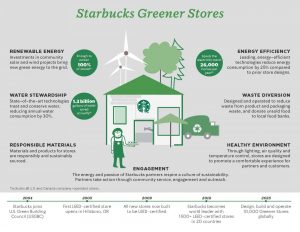
And if you visit your local Starbucks often, you must have noticed the reusable coffee cups! To spread environmental awareness to their audience and the general public, Starbucks supports green buildings and local farms to encourage sustainable living. This brand also contributes to recycling campaigns, which buyers love as 44% believe it’s crucial for the businesses they purchase from to support recycling.
While some of Starbucks’ audience hated the green cups (because it wasn’t Christmas-themed as promised), most social media users were on board. This brand has received a lot of customer appreciation for its efforts to become eco-friendly.
What’s valuable about Starbucks’ success story of going green and that you should consider for your brand is:
The Body Shop has been all about environmental awareness since its beginning. This brand has made several significant positive impacts on environmental and social issues.
Leaping Bunny has approved all The Body Shop’s products. This is the highest standard for non-animal tested products. And all the materials that go into products, packing, and delivery are eco-friendly solutions with no exceptions.
The Body Shop also spreads awareness about environmental issues like recycling and climate control alongside their contribution to domestic violence and AIDs awareness. This brand ensures they don’t use content that offends women in its marketing campaigns. Over the next few years, The Body Shop aims to have 100% sustainable energy resources in stores and green building solutions.
A big part of The Body Shop’s long-standing success is how seriously this company approaches social and environmental issues. Besides providing products that enhance consumers’ lives, they also make the extra effort to improve society and how we perceive the planet.
What you should take away from how The Body Shop uses environmental marketing is:
Summary: 8 Environmental Marketing Success Stories and Their Key Takeaways
Adopting a more eco-friendly approach is not only good for the planet, but it is also good for your brand. Environmental issues are at the forefront of everyone’s mind and are guiding purchasing decisions to a significant extent. E
Environmental marketing allows you to make the most of that opportunity to make more sales, while also reflecting well on your brand and building your reputation and credibility in a positive way.
However, to be effective environmental marketing must be honest and transparent. Engaging in greenwashing practices will do more harm to your brand than any temporary bump in sales is worth!
Environmental marketing is when businesses consider how their marketing materials and campaigns impact the environment, and then use that as part of their marketing messaging. Environmental marketing is distinct from 'greenwashing' in that greenwashing makes false claims or exaggerates in order to make the brand appear to be a more eco-friendly choice than it really is. Environmental marketing is truthful, highlighting the brand's real actions, characteristics, or values that make it a sustainable brand. Read the full guide to learn more about environmental marketing, how it differs from greenwashing, and the benefits of using environmental marketing for your brand.
Greenwashing refers to marketing that dishonestly portrays a brand as being an eco-friendly choice. Examples of greenwashing include brands that use green/nature-inspired packaging to make it seem like an eco-brand or exaggerate claims like the recyclability of their packaging or the origins of their raw materials. A common greenwashing tactic is to make the assertion that the brand is the 'lesser of two evils' and a better option than competing brands, because the other brands are somehow worse for the environment, without doing anything to mitigate or lessen their impact on the environment. Read the full guide to learn more and see examples of honest environmental marketing.
The best brand environmental marketing success stories include Pokemon Go, Between Green, The Body Shop, Unilever, Starbucks and Priority Direct. Other brands with fantastic environmental marketing success stories are Hunderunde and Patagonia. Read this article to find out what is environmental marketing and how this differs from greenwashing.
Forbes: Do Customers Really Care About Your Environmental Impact?
Harvard Business Review: Buying Green? Field Experimental Tests of Consumer Support for Environmentalism.
National Renewable Energy Laboratory: The Value and Cost of Solar Electricity